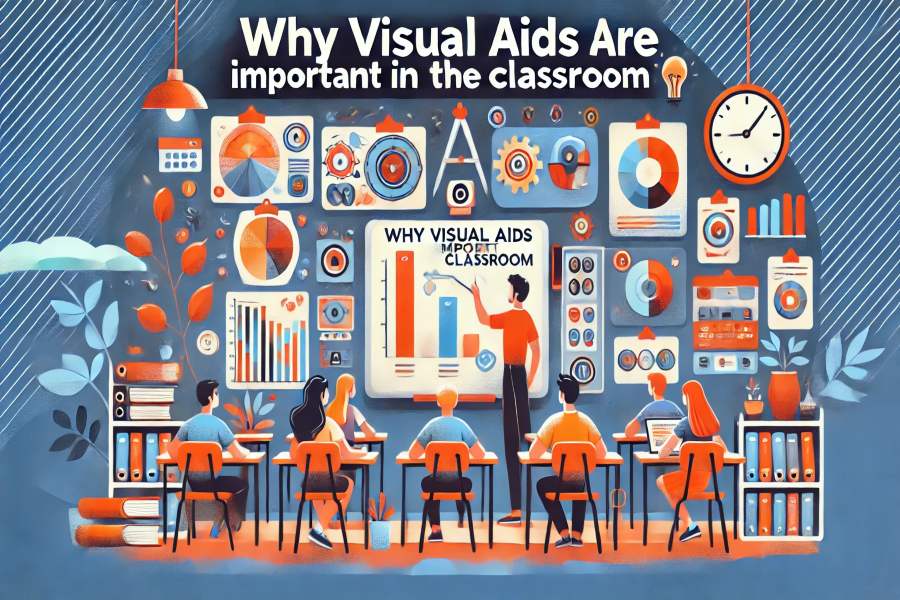Visual aids have become an integral part of modern education, vital in enhancing the learning experience. Educators in today’s diverse classrooms constantly seek effective methods to engage students and improve their comprehension. Visual aids, including charts, diagrams, videos, and interactive whiteboards, provide a powerful way to convey information and concepts. These tools capture students’ attention and cater to different learning styles, making lessons more inclusive and dynamic. As the educational landscape evolves, understanding why visual aids are important in the classroom can help educators leverage their potential to create a more interactive and effective learning environment. This article delves into the significance of visual aids in education, exploring their benefits, implementation strategies, and their profound impact on students’ academic success.
Why Visual Aids Are Important In The Classroom?
Visual aids are crucial in the classroom because they enhance learning by making information more accessible and engaging. They cater to different learning styles, improve retention, and help clarify complex concepts, making lessons more effective and inclusive.
The Importance Of Visual Aids In The Classroom
Visual aids are essential tools in education, significantly enhancing the learning process. These tools help to break down complex information into easily digestible parts, making it simpler for students to understand and retain knowledge. Teachers who incorporate visual aids into their lessons often find that students are more engaged and attentive. This increased engagement leads to better academic performance and a deeper understanding of the subject matter. Furthermore, visual aids cater to different learning styles, ensuring that all students, regardless of their preferred method of learning, can benefit from the lesson.
In addition to improving comprehension, visual aids also aid in memory retention. When students can see and interact with information, they are more likely to remember it. This is particularly true for visual learners, who make up a significant portion of any classroom. By using visual aids, teachers can create a more inclusive environment that supports the diverse needs of their students.
Another important aspect of visual aids is their ability to make lessons more interactive. Interactive whiteboards, for example, allow students to participate actively in the learning process. This active participation makes learning more fun and helps students develop critical thinking and problem-solving skills. These skills are essential for success both in and out of the classroom.
Visual aids also help to clarify complex concepts. Subjects such as mathematics and science often involve abstract ideas that can be difficult for students to grasp. By using diagrams, charts, and other visual tools, teachers can make these concepts more concrete and easier to understand. This clarity can lead to better academic outcomes and a more positive attitude towards challenging subjects.
Benefits And Implementation Of Visual Aids
1. Enhancing Engagement
Visual aids significantly boost student engagement by making lessons more interesting and interactive. Tools like videos and infographics capture students’ attention, making them more likely to participate in discussions and activities.
2. Catering to Diverse Learning Styles
Students have different learning preferences, with some learning better through visual means. Visual aids cater to visual learners by providing information in a format that is easier for them to understand and remember.
3. Improving Retention and Comprehension
When information is presented visually, students are more likely to retain and comprehend it. Visual aids break down complex information, making it easier to digest and remember.
4. Facilitating Better Understanding of Complex Concepts
Subjects like mathematics and science can be challenging due to their abstract nature. Visual aids help simplify these subjects by providing concrete representations of abstract concepts, making them easier to grasp.
5. Encouraging Active Participation
Interactive visual aids, such as smartboards, encourage students to actively participate in lessons. This active engagement fosters critical thinking and problem-solving skills, which are crucial for academic success.
Effective Strategies For Using Visual Aids
Using visual aids effectively in the classroom requires careful planning and consideration. Here are some strategies to maximize their impact:
- Integrate Visuals with Verbal Explanations: Combine visual aids with verbal explanations to reinforce learning and ensure that all students understand the material.
- Use a Variety of Visual Aids: Incorporate different types of visual aids, such as charts, videos, and diagrams, to cater to various learning styles and keep lessons interesting.
- Ensure Visual Clarity and Relevance: Choose clear and relevant visual aids that directly relate to the lesson content. Avoid overly complex or unrelated visuals that may confuse students.
- Encourage Student Interaction: Use interactive visual aids, such as smartboards or educational apps, to involve students in the learning process and promote active participation.
- Evaluate the Effectiveness of Visual Aids: Regularly assess the impact of visual aids on student learning and make adjustments as needed to improve their effectiveness.
An Alternative Perspective On Visual Aids
While visual aids are undeniably beneficial in the classroom, it’s important to consider potential drawbacks. Over-reliance on visual aids can sometimes lead to passive learning, where students become dependent on visuals and struggle to learn through other methods. Additionally, creating and integrating visual aids can be time-consuming for teachers, potentially detracting from other important aspects of lesson planning and delivery.
Furthermore, not all students may benefit equally from visual aids. For some learners, particularly those with visual impairments, traditional visual aids may not be effective. In these cases, teachers must find alternative methods to ensure that all students have equal access to learning resources.
Despite these challenges, the overall benefits of visual aids in the classroom far outweigh the drawbacks. By being mindful of potential issues and striving to use visual aids in a balanced and inclusive way, teachers can maximize their positive impact on student learning.
Practical Tips For Incorporating Visual Aids
Choosing the Right Visual Aids: Selecting appropriate visual aids is crucial. Ensure that the visuals align with the lesson objectives and are suitable for the student’s age and comprehension levels.
Integrating Visual Aids Seamlessly: Visual aids should complement the lesson, not distract from it. Integrate them seamlessly into the lesson plan to enhance understanding and engagement without overwhelming students.
Encouraging Student Interaction with Visuals: Promote active learning by encouraging students to interact with visual aids. Use tools like interactive whiteboards and educational apps to involve students in the learning process.
Assessing the Impact of Visual Aids: Regularly evaluate how visual aids are affecting student learning. Gather feedback from students and make necessary adjustments to improve their effectiveness.
Conclusion
Visual aids play a crucial role in modern education by enhancing learning, improving retention, and catering to diverse learning styles. When used effectively, they make lessons more engaging and help students understand complex concepts. Teachers should strive to integrate visual aids seamlessly into their lessons, ensuring that they complement the teaching material and contribute positively to student learning outcomes. The lasting impact of visual aids in education underscores their importance as essential tools for effective teaching.
FAQs
1. Why Are Visual Aids Important In The Classroom?
Visual aids enhance learning by making information more accessible and engaging, catering to different learning styles, and improving retention and comprehension.
2. How Do Visual Aids Benefit Students?
Visual aids benefit students by increasing engagement, improving understanding of complex concepts, and making lessons more interactive and enjoyable.
3. What Types Of Visual Aids Are Commonly Used In Classrooms?
Common visual aids include charts, diagrams, videos, infographics, and interactive whiteboards.
4. Can Visual Aids Be Used For All Subjects?
Yes, visual aids can be adapted for use in all subjects to help clarify concepts and enhance learning.
5. How Can Teachers Effectively Integrate Visual Aids Into Their Lessons?
Teachers can effectively integrate visual aids by ensuring they are relevant to the lesson content, combining them with verbal explanations, and encouraging student interaction with the visuals.












































Leave a Reply